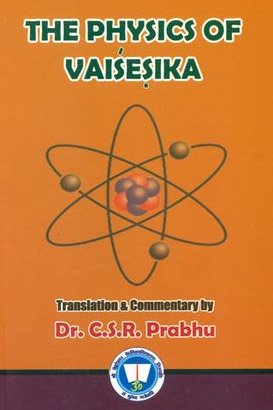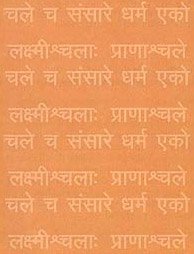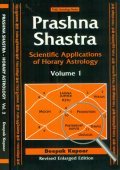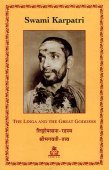Adharma, Adharmā: 26 definitions
Introduction:
Adharma means something in Buddhism, Pali, Hinduism, Sanskrit, Jainism, Prakrit, Marathi, Hindi. If you want to know the exact meaning, history, etymology or English translation of this term then check out the descriptions on this page. Add your comment or reference to a book if you want to contribute to this summary article.
Alternative spellings of this word include Adharm.
Images (photo gallery)
In Hinduism
Shaivism (Shaiva philosophy)
Source: Wisdom Library: Kubjikāmata-tantraAdharmā (अधर्मा):—Sixth of the eight Mātṛs born from the body of Ātmī, according to the Kubjikāmata-tantra. These eight sub-manifestations (mātṛ), including Adharmā, symbolize the different kinds of souls, as well as the impurities by which these souls are bound (except for Niṣkala or Śiva). They are presided over by the Bhairava Caṇḍa and his consort Brāhmī. Ātmī is the second of the Eight Mahāmātṛs, residing within the Mātṛcakra (third of the five cakras) and represents the ātman.
Source: Brill: Śaivism and the Tantric TraditionsAdharma (अधर्म) refers to “(past and future) demerits”, according to the Svacchandatantra verse 4.141-145.—Accordingly, “[...] The other form [of bubhukṣu initiation] is the lokadharmiṇī, which destroys both past and future demerit (adharma). That lokadharmiṇī-dīkṣā is known to exclude the obligation to propitiate mantras [by means of purvasevā etc.]. However, when the current body breaks, [the candidate] experiences [the series of eight supernatural natural powers] starting with becoming very small. Having experienced [these] enjoyments he moves upwards to whichever [cosmic level] the Guru has joined him [by yojanikā]. Whether this is at the sakala or niṣkala level [of Śiva] depends on [the preference of] the candidate and Guru”.

Shaiva (शैव, śaiva) or Shaivism (śaivism) represents a tradition of Hinduism worshiping Shiva as the supreme being. Closely related to Shaktism, Shaiva literature includes a range of scriptures, including Tantras, while the root of this tradition may be traced back to the ancient Vedas.
Purana and Itihasa (epic history)
Source: archive.org: Puranic Encyclopedia1) Adharma (अधर्म).—A description of the lineage of Adharma is found in Agni Purāṇa. Hiṃsā (violence) is the consort of Adharma. The couple procreated two children, Anṛta and Nikṛti, and from them sprang up Bhaya (fear), Naraka (Hell), Māyā (illusion), Vedanā (pain) etc. And, out of them Māyā brought forth Death, the destroyer of (all) objects. Vedanā, in its turn produced Sorrow and Grief out of Raurava. From Death were born Disease, Senility, Sorrow, Intense desire and Anger. (Agni Purāṇa, Chapter 20).
2) Adharma (अधर्म).—Adharma is a person who is an embodiment of Adharmas. (Mahābhārata Ādi Parva, Chapter 66, Verse 53). Adharma’s wife Nirṛti delivered 3 children; Bhaya, Mahābhaya and Mṛtyu. Adharma had another son, Darpa (conceit) born of Wealth. (Mahābhārata Śānti Parva, Chapter 90, Verse 27).
Source: Cologne Digital Sanskrit Dictionaries: The Purana Index1a) Adharma (अधर्म).—A son of Brahmā, born of his back.1 Had for his wife Mrṣā.2 Three chief characteristics—pride, luxury and intoxication.3 His son was Dambha and daughter Māyā, both of whom were adopted later on by the childless Nirṛti.4 Five branches of: vidharma, paradharma, ābhāsa, upamā, and chala.5
- 1) Bhāgavata-purāṇa III. 12. 25.
- 2) Ib. IV. 8. 2.
- 3) Ib. I. 17. 24.
- 4) Ib. IV. 8. 2.
- 5) Ib. VII. 15. 12-14.
1b) Wife, Hiṃsā; sons Nikṛti, Anṛta. (daughter Nikṛtī, Viṣṇu-purāṇa).*
- * Brahmāṇḍa-purāṇa II. 9. 63; Vāyu-purāṇa 10. 39; Viṣṇu-purāṇa I. 7. 32.
Adharma (अधर्म) is a name mentioned in the Mahābhārata (cf. I.60.51) and represents one of the many proper names used for people and places. Note: The Mahābhārata (mentioning Adharma) is a Sanskrit epic poem consisting of 100,000 ślokas (metrical verses) and is over 2000 years old.

The Purana (पुराण, purāṇas) refers to Sanskrit literature preserving ancient India’s vast cultural history, including historical legends, religious ceremonies, various arts and sciences. The eighteen mahapuranas total over 400,000 shlokas (metrical couplets) and date to at least several centuries BCE.
Vaisheshika (school of philosophy)
Source: Wisdom Library: VaiśeṣikaAdharma (अधर्म, “demerit”) is one of the additional guṇas (‘qualities’) added by Praśastapāda, on top of the seventeen guṇas in the Vaiśeṣika-sūtras. These guṇas are considered as a category of padārtha (“metaphysical correlate”). These padārthas represent everything that exists which can be cognized and named. Together with their subdivisions, they attempt to explain the nature of the universe and the existence of living beings.

Vaisheshika (वैशेषिक, vaiśeṣika) refers to a school of orthodox Hindu philosophy (astika), drawing its subject-matter from the Upanishads. Vaisheshika deals with subjects such as logic, epistemology, philosophy and expounds concepts similar to Buddhism in nature
Pancaratra (worship of Nārāyaṇa)
Source: archive.org: Isvara Samhita Vol 5Adharma (अधर्म) or Adharmamudrā is the name of a mudrā described in the Īśvarasaṃhitā 50-53.—Accordingly, “the two hands are to be kept apart and then the index fingers are to be joined face to face; leaving this formation for the two middle fingers; the ring fingers shall be left out, this shall be done to the two little fingers. This shall be done to the two thumbs while forming each. These four mudrās are for dharma and others and adharma and others. The lotus that exists above them (dharma and others) was described before with mantras”.
Mūdra (eg., Adharma-mudrā) is so called as it gives joy to the tattvas in the form of karman for those who offer spotless worship, drive out the defects which move about within and without and sealing up of what is done.

Pancaratra (पाञ्चरात्र, pāñcarātra) represents a tradition of Hinduism where Narayana is revered and worshipped. Closeley related to Vaishnavism, the Pancaratra literature includes various Agamas and tantras incorporating many Vaishnava philosophies.
Nyaya (school of philosophy)
Source: Shodhganga: A study of Nyāya-vaiśeṣika categoriesAdharma (अधर्म, “demerit”) and Adharma (demerit) refers to two of the twenty-four guṇas (qualities) according to Praśastapāda and all the modern works on Nyāya-Vaiśeṣika.—Dharma (merit) and adharma (demerit) constitute adṛṣṭa (destiny). Radhakrishnan says “Dharma and adharma are qualities of the soul by virtue of which it enjoys happiness or suffers misery. Adṛṣṭa is the unseen power produced by souls and things, which brings about the cosmic order and enables selves to reap the harvest of their past experiences”.
Praśastapāda points out that dharma is a quality of puruṣa i.e., the self. It produces happiness and liberation. It is caused by the contact of the self with the antaḥkaraṇa (inner organ), conditioned by pure thoughts and decisions. It is not perceptible by the senses and is destroyed by the experience of final happiness. Demerit (adharma), on the other hand, produces undesirable results. It is produced by doing prohibited action, not performing prescribed duties, neglect and impurity of motives. Viśvanātha describes dharma as that which leads to heaven etc. In his view, dharma consists of actions like bath in the gangas and sacrifices. Similarly, adharma is the cause of hell etc. It is produced by such actions which are condemnable. Viśvanātha also maintains that these two are produced by subtle impressions (vāsana) and are destroyed by knowledge also.
Dharma and adharma are the special qualities of the self and are imperceptible by the senses. According to Annaṃbhaṭṭa, among the aforementioned eight special qualities of the self, buddhi, icchā and prayatna are both eternal and noneternal. In case of īśvara these qualities are eternal and in case of the jīva these are non-eternal.

Nyaya (न्याय, nyaya) refers to a school of Hindu philosophy (astika), drawing its subject-matter from the Upanishads. The Nyaya philosophy is known for its theories on logic, methodology and epistemology, however, it is closely related with Vaisheshika in terms of metaphysics.
Vaishnavism (Vaishava dharma)
Source: Pure Bhakti: Bhagavad-gita (4th edition)Adharma (अधर्म) refers to “irreligion”. (cf. Glossary page from Śrīmad-Bhagavad-Gītā).

Vaishnava (वैष्णव, vaiṣṇava) or vaishnavism (vaiṣṇavism) represents a tradition of Hinduism worshipping Vishnu as the supreme Lord. Similar to the Shaktism and Shaivism traditions, Vaishnavism also developed as an individual movement, famous for its exposition of the dashavatara (‘ten avatars of Vishnu’).
Yoga (school of philosophy)
Source: ORA: Amanaska (king of all yogas): A Critical Edition and Annotated Translation by Jason BirchAdharma (अधर्म) refers to “unmeritorious actions”, according to the Viṣṇudharma verse 96.25-26.—Accordingly, while discussing the cessation of mind: “Since [duality is based on mental activity and non-duality on the ultimate truth], the activities of mind, which are caused by meritorious and unmeritorious actions (adharma), should be stopped. Because of their cessation, duality does not arise. This duality, which consists of whatever is moving and unmoving, is an object of mind. When the mind has become without thoughts, then one obtains the absence of duality”.

Yoga is originally considered a branch of Hindu philosophy (astika), but both ancient and modern Yoga combine the physical, mental and spiritual. Yoga teaches various physical techniques also known as āsanas (postures), used for various purposes (eg., meditation, contemplation, relaxation).
General definition (in Hinduism)
Source: Wisdom Library: HinduismAdharma (अधर्म, “sin”):—In Vedic hinduism, he represents Unrighteousness and is the husband of Nirṛti. They have three sons:
- Mṛtyu,
- Bhaya
- and Mahābhaya
In Buddhism
Mahayana (major branch of Buddhism)
Source: academia.edu: A Study and Translation of the GaganagañjaparipṛcchāAdharma (अधर्म) refers to “untruth”, according to the Gaganagañjaparipṛcchā: the eighth chapter of the Mahāsaṃnipāta (a collection of Mahāyāna Buddhist Sūtras).—Accordingly, “[...] Then again, the Bodhisattva, the great being Gaganagañja uttered these verses to that Bodhisattva, the great being Guṇarājaprabhāsa: ‘(29) [...] The one who delights in the well done (sukṛta) and perfected dharma, who is free from the twofold grasping (dvayagrāha) of truth or untruth (dharma-adharma), and who constantly takes pleasure in the dharma through the excellent concentration, him I ask about the of the space-like subject of mind. [...]’”.

Mahayana (महायान, mahāyāna) is a major branch of Buddhism focusing on the path of a Bodhisattva (spiritual aspirants/ enlightened beings). Extant literature is vast and primarely composed in the Sanskrit language. There are many sūtras of which some of the earliest are the various Prajñāpāramitā sūtras.
In Jainism
General definition (in Jainism)
Source: Encyclopedia of Jainism: Tattvartha Sutra 5: The category of the non-livingAdharma (अधर्म) refers to the “medium of rest” according to the 2nd-century Tattvārthasūtra 5.17.—The functions of the media of motion (dharma) and rest (adharma) are to assist (upagraha) motion (gati) and rest respectively. The function of the medium of motion (dharma) is to support / assist in the motion of moving objects (living beings and matter). The function of the medium of rest (adharma) is to support the state of rest of objects (living beings and matter).

Jainism is an Indian religion of Dharma whose doctrine revolves around harmlessness (ahimsa) towards every living being. The two major branches (Digambara and Svetambara) of Jainism stimulate self-control (or, shramana, ‘self-reliance’) and spiritual development through a path of peace for the soul to progess to the ultimate goal.
Languages of India and abroad
Marathi-English dictionary
Source: DDSA: The Molesworth Marathi and English Dictionaryadharma (अधर्म).—m (S) Unrighteousness, iniquity, sin; all behaviour contrary to the śruti and smṛti or religious and legal institutes. 2 A sin, a crime, a wrong deed.
Source: DDSA: The Aryabhusan school dictionary, Marathi-Englishadharma (अधर्म).—m Unrighteousness, a sin, a crime.
Marathi is an Indo-European language having over 70 million native speakers people in (predominantly) Maharashtra India. Marathi, like many other Indo-Aryan languages, evolved from early forms of Prakrit, which itself is a subset of Sanskrit, one of the most ancient languages of the world.
Sanskrit dictionary
Source: DDSA: The practical Sanskrit-English dictionaryAdharma (अधर्म).—[na. ta.]
1) Unrighteousness, irreligion, impiousness, wickedness, injustice; °दण्डनम् (daṇḍanam) Manusmṛti 8.127 unjust punishment; अधर्मेण (adharmeṇa) unjustly, in an improper way; यश्चाधर्मेण पृच्छति (yaścādharmeṇa pṛcchati) Manusmṛti 2.111; an unjust act; a guilty or wicked deed; sin; °चारिन् (cārin) committing unjust or unrighteous deeds; so °आत्मन् (ātman) of an irreligious spirit; तदा कथम्° भीरुः (tadā katham° bhīruḥ) Ś.5; °मय (maya) full of wickedness or sin; for definitions &c. of धर्म (dharma) and अधर्म (adharma) See Tarka K. P.19. (dharma and adharma are two of the 24 qualities mentioned in Nyāya, and they pertain only to the soul. They are the peculiar causes of pleasure and pain respectively. They are imperceptible, but inferred from reasoning and from transmigration.)
2) Name of a Prajāpati or of an attendant of the sun.
-rmā Unrighteousness personified.
-rmam Devoid of attributes, an epithet of ब्रह्म (brahma)
Derivable forms: adharmaḥ (अधर्मः).
Source: Cologne Digital Sanskrit Dictionaries: Benfey Sanskrit-English DictionaryAdharma (अधर्म).—m. 1. wrong, [Mānavadharmaśāstra] 1, 26. 2. unjust way, [Mānavadharmaśāstra] 2, 111. 3. demerit, Bhāṣāp. 160.
Adharma is a Sanskrit compound consisting of the terms a and dharma (धर्म).
Source: Cologne Digital Sanskrit Dictionaries: Cappeller Sanskrit-English DictionaryAdharma (अधर्म).—[masculine] unrighteousness, injustice, demerit (often personif.).
Source: Cologne Digital Sanskrit Dictionaries: Monier-Williams Sanskrit-English Dictionary1) Adharma (अधर्म):—[=a-dharma] m. unrighteousness, injustice, irreligion, wickedness
2) [v.s. ...] demerit, guilt
3) [v.s. ...] Name of a Prajāpati (son of Brahmā, husband of Hiṃsā or Mṛṣā)
4) [v.s. ...] Name of an attendant of the sun
5) Adharmā (अधर्मा):—[=a-dharmā] [from a-dharma] f. unrighteousness (personified and represented as the bride of death).
Source: Cologne Digital Sanskrit Dictionaries: Goldstücker Sanskrit-English DictionaryAdharma (अधर्म):—[tatpurusha compound] 1. m.
(-rmaḥ) 1) Unrighteousness, injustice, all behaviour contrary to the Śruti and Smṛti, or religious and legal institutions.
2) (In philosophy.) According to the Nyāya and Vaiśeṣika: moral demerit, the result of doing what is forbidden, the peculiar cause of pain, one of the twenty-four qualities united with substance.—According to the Sāṅkhya, one of the changeable (vaikṛtika) dispositions (bhāva) of the mind, which being the efficient cause, makes the soul migrate into an animal, a deer, a bird, a reptile, a vegetable, a mineral.—According to the Buddhistic doctrine it is the consequence of upādāna or exertion of body or speech.—According to the Jainas it is that which causes the soul in general to continue embarrassed with body notwithstanding its capacity for ascent and natural tendency to soar.
3) As a personification Adharma occurs in the Purāṇas as one of the Prajāpatis or mind-born sons of Brahmā; his wife is Hiṃsā (mischief) on whom he begot Anṛta (falsehood) and Nikṛti (immorality) or according to others, Mṛṣā (falsehood) and his children Dambha (hypocrisy) and Māyā (deceit) who were adopted by Nirṛti (misfortune).—Adharma is also mentioned as one of the eighteen servants of the sun. 2. f.
(-rmā) According to the Śāktas a kalā or part of the original or Mūla-prakṛti and personified as the bride of Mṛtyu or Death. E. a neg. and dharma.
Source: Cologne Digital Sanskrit Dictionaries: Yates Sanskrit-English DictionaryAdharma (अधर्म):—[a-dharma] (rmmaḥ) 1. m. Unrighteousness.
Source: DDSA: Paia-sadda-mahannavo; a comprehensive Prakrit Hindi dictionary (S)Adharma (अधर्म) in the Sanskrit language is related to the Prakrit word: Adhamma.
[Sanskrit to German]
Sanskrit, also spelled संस्कृतम् (saṃskṛtam), is an ancient language of India commonly seen as the grandmother of the Indo-European language family (even English!). Closely allied with Prakrit and Pali, Sanskrit is more exhaustive in both grammar and terms and has the most extensive collection of literature in the world, greatly surpassing its sister-languages Greek and Latin.
Hindi dictionary
Source: DDSA: A practical Hindi-English dictionaryAdharma (अधर्म) [Also spelled adharm]:—(nm) vice; wrong; sin, sinful act; unrighteousness, immorality; ~[rmī] sinful; vicious; an evildoer, a sinner.
...
Kannada-English dictionary
Source: Alar: Kannada-English corpusAdharma (ಅಧರ್ಮ):—
1) [noun] unrighteousness; that which is against the a) original nature, b) established religious or moral rules.
2) [noun] an act, intention or a thought which is not justifiable morally; moral or spiritual decadence.
3) [noun] (Jain.) that which impedes the freeness of the soul.
Kannada is a Dravidian language (as opposed to the Indo-European language family) mainly spoken in the southwestern region of India.
See also (Relevant definitions)
Partial matches: Dharma, A, Tarma.
Starts with (+11): Adharmabhiru, Adharmacarana, Adharmacari, Adharmacarin, Adharmacarya, Adharmadandana, Adharmadravya, Adharmajna, Adharmakama, Adharmamahisha, Adharmamaya, Adharmamudra, Adharmanimitta, Adharmanishtha, Adharmaparavant, Adharmarata, Adharmarthika, Adharmarupin, Adharmasharana, Adharmastikaya.
Ends with (+218): Achittadharma, Acintyadharma, Acittadharma, Adbhutadharma, Agnilakshadharma, Agradharma, Ahavadharma, Ahimsadharma, Akarshanadharma, Akopyadharma, Akshadharma, Akushaladharma, Alayadharma, Amritadharma, Anasravadharma, Anavartikadharma, Anekadharma, Anugatadharma, Anutpattikadharma, Anyadharma.
Full-text (+187): Adharmastikaya, Mahabhaya, Adharmatman, Mrisha, Dharma, Anrita, Adharmika, Adharmacarin, Dambha, Adharm, Adharmadandana, Adharmin, Adharmamaya, Adharmacarya, Adharmacarana, Adharmaparavant, Bhaya, Nirriti, Nikriti, Adharmavarttin.
Relevant text
Search found 155 books and stories containing Adharma, Adharmā, A-dharma, A-dharmā; (plurals include: Adharmas, Adharmās, dharmas, dharmās). You can also click to the full overview containing English textual excerpts. Below are direct links for the most relevant articles:
Shrimad Bhagavad-gita (by Narayana Gosvami)
Verse 18.31 < [Chapter 18 - Mokṣa-yoga (the Yoga of Liberation)]
Verse 18.32 < [Chapter 18 - Mokṣa-yoga (the Yoga of Liberation)]
Verse 1.39 < [Chapter 1 - Sainya-Darśana (Observing the Armies)]
Manusmriti with the Commentary of Medhatithi (by Ganganatha Jha)
Verse 4.173 < [Section XIV - Other Duties]
Verse 11.228 < [Section XXX - Confession and Repentance]
Verse 2.1 < [Section I - Dharma defined]
Lankavatara Sutra (by Daisetz Teitaro Suzuki)
Garga Samhita (English) (by Danavir Goswami)
Verse 5.7.52 < [Chapter 7 - The Killing of Kuvalayāpīḍa]
Verse 5.7.43 < [Chapter 7 - The Killing of Kuvalayāpīḍa]
Sahitya-kaumudi by Baladeva Vidyabhushana (by Gaurapada Dāsa)
Text 4.91 < [Chapter 4 - First-rate Poetry]
Text 6.3 < [Chapter 6 - Third-rate Poetry and Super-excellent Poetry]
Text 10.33 < [Chapter 10 - Ornaments of Meaning]
Taittiriya Upanishad Bhashya Vartika (by R. Balasubramanian)
Verse 2.570 < [Book 2 - Brahmavallī]
Verse 2.125-126 < [Book 2 - Brahmavallī]
Verse 2.743 < [Book 2 - Brahmavallī]
Related products



